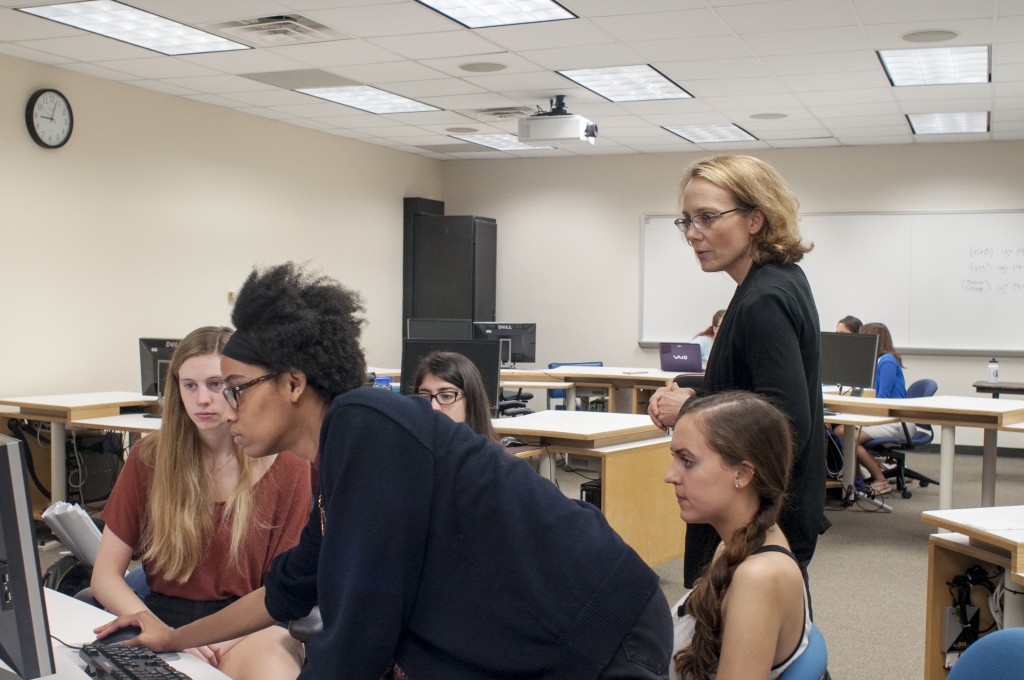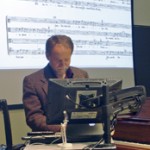The impact of technology on college student learning is the subject of several recent studies, both at Rice and in Michigan. The Office of Information Technology (OIT) worked with the Center for Teaching Excellence to develop survey questions about student academic technology use and experience. In June 2015, over 1000 new undergraduates received an invitation to complete the survey and about 75% responded. Responses of 750 students in the class of 2019 regarding their experiences with — and future plans for — using technology in school reveal predominant use of laptops and smartphones.
Archive for the ‘Teaching and Tech’ Category
New Undergraduate Academic Technology Survey
Wednesday, July 15th, 2015Dr. Justin Denney: The Undergraduate Difference
Monday, June 15th, 2015What makes it a good day to come to work for Dr. Justin Denney, Assistant Professor of Sociology and Director of the Kinder Institute Urban Health Program? “When I get out of bed in the morning and know I can be helping students see and figure out how the world works–and it is kind of uncomfortable to find the world works in this way–but the message is that inequalities exist, they are real, but we are responsible for them and we can change them. And in this optimistic sense, I tell them, ‘now go out there and change the world. We can do better,’” explains Denney.
Dr. Ann Saterbak and Dr. Matthew Wettergreen: Building an Engineering Tool Kit
Tuesday, June 9th, 2015
Dr. Ann Saterbak advises a group on their semester-long projects in her course Engineering 120: Introduction to Engineering Design.
From the moment engineers enter the Sallyport to the moment they leave, Dr. Ann Saterbak and Dr. Matthew Wettergreen are instrumental in their development. Rice offers a high caliber engineering education with rigorous courses, research challenges, and the Oshman Engineering Design Kitchen where skills learned in the classroom can be applied to innovatively solve problems. This thorough education experience that intertwines theory and research attracts engineering students from near and far. However, freshman must enroll in many math and science prerequisites before they can explore upper level engineering courses. To offer students a foresight of the engineering field as they complete these requirements, Saterbak and Wettergreen have developed Introduction to Engineering Design (ENGI 120). Dr. Wettergreen explains, “Students are looking for authentic experiences, and engineering design classes offer experiences that are the real world.”
Together, Saterbak and Wettergreen have teamed up to develop ENGI 120 as a design-based flipped classroom experience. ENGI 120 offers students an active learning classroom experience. The planning work for this class begins the summer before the academic year when Saterbak and Wettergreen talk with personal acquaintances and professionals in the Houston community about potential project ideas appropriate for first-year students. At the beginning of the semester, students are assigned to teams and given one of these problems to solve over the course of the semester. Originally, the first part of each one and a half hour class was a lecture on a step in the engineering design process followed by team time for groups to work together on their projects. However, Saterbak and Wettergreen discovered that the only way students were applying the lecture material was during the actual project design process. So, as engineers often are, they were innovative and restructured their classroom.
About a year and half ago, Saterbak and Wettergreen hired a production firm with some funding from a National Science Foundation engineering grant. In total, they filmed 32 videos ranging in length from 1-11 minutes that they started using during the fall semester of 2014. This project is still in progress, and they will have five more of their lectures flipped by next fall. Most of their video lectures include bullet points, active examples, and a talking head in the corner of the videos. Saterbak and Wettergreen created the storyboards for all of the videos, but they also had guest speakers such as Dr. Maria Oden and Dr. Marcia O’Malley give lectures on specific topics, too. Last summer, they attended a conference on engineering education where they were able to video four professionals from other universities with different perspectives and areas of expertise. While these videos are specific to Rice’s ENGI 120, Dr. Saterbak says, “Our goal is to create a repository of videos that other universities can use to construct their courses, too.”
Before class, students are assigned to watch these videos. Once they arrive in class, they participate in exercises with their groups, one of which usually relates to their projects directly. They spend about half the class actively learning the concepts from the video lecture. During the second 45 minutes of class, the groups have time to work on their semester-long projects. While completing the projects takes many hours outside of class as well, this gives the freshman automatic group meetings twice every week when Saterbak and Wettergreen are there to offer advice and suggestions. Some examples of projects that freshmen students have completed include a bike rack for METRO buses in Houston, protective homes for baby birds for the Houston Zoo, and an enrichment device for swamp monkeys for the Houston Zoo.
Part of the purpose in offering design experiences early on in Rice careers is that it prepares students to work in teams and collaborate on solving problems. By graduation, Rice engineers know how to communicate within a team, how to divide labor amongst a group, and how to brainstorm collaboratively, which prepares them to work in engineering firms, as consultants, or in many other careers. While Rice engineers gather these tools from upper level experiences such as the required senior engineering design projects, Saterbak and Wettergreen realized that the earlier students develop these skills, the more prepared they will be. Thus, ENGI 120 was born. Their first cohort of 80 ENGI 120 students are graduating this year, and Saterbak and Wettergreen do think that these students were better prepared going into senior design as a result of starting their preparation for collaborative work early on in college.
According to Saterbak and Wettergreen, “ENGI 120 tricks students into learning by giving them a real world project with intense collaboration, professional writing, kinesthetic learning, and an external client that offers them applied instead of theoretical learning.” Overall, students give positive feedback, and students who like their teams especially enjoy the class. Clearly, students notice and appreciate the dedication of these two professors because the junior and senior classes recently honored Saterbak with the Nicolas Salgo Distinguished Teacher Award for 2015. Saterbak and Wettergreen help students understand how to collaborate, how to problem-solve, and how to communicate their ideas, which, from their first year at Rice, equips Rice engineering students with tools to help them flourish throughout their student and professional careers.
Dr. Margaret Beier: The Psychology of Learning
Monday, June 1st, 2015When Dr. Margaret Beier, Associate Professor of Psychology, was an undergraduate student, most of her classes were taught lecture style. On her first day teaching at Rice University in 2004, Beier entered the classroom, walked to the podium, finished her lecture in thirty minutes, and dismissed her students twenty minutes before the class officially ended. As she progressed through the semester, Beier used OWL-space to garner student feedback, and she used the advice to modify her course to be more interactive. She realized the importance of more engaged projects in the classroom, and this has drastically altered her teaching style from that first day. Now, Beier says, “There is an expectation from students and faculty alike that the lecture-style classroom is not the best way to do things.” While Beier admits that she did have professors who lectured and were quite impactful, more interactive courses have proved to be more meaningful for her students – so Beier has made changes over the years to make her courses more interactive.
A recent example of Beier’s commitment to listening to student feedback is in her role of bringing back Psychological Testing (PSYC 329), a course that had once been offered at Rice but had not been offered in a long time. Beier explains, “I think it’s really important to engage students in class, the best thing you can have them do is what psychologists do: execute experiments and develop measures on a small scale that are similar to what psychologists use.” Following registration last fall, undergraduate students majoring in Psychology were saying that there were not enough Psychology electives offered for them, so, the Psychology department decided to add another course to offer a project-based class for students. Psychological Testing is a semester-long course with 15-20 students divided into 3-4 groups. Over the first half of the semester, students learn about psychometric reliability and the validity of testing. Later in the semester, students develop their own psychological tests and evaluate them through an empirical study they design.
While Beier only had two months to work on developing this course before the start of the semester, she utilized the time available to come up with a plan. In order to help steer students towards developing projects that are both feasible and original with the time and resources allotted, Beier prompts her students with a few articles in various areas such as cognitive psychology, social psychology, and personality psychology. To pique students’ interest in topics, Beier specifically selects introductory articles across those areas and asks students to use these ideas to develop their own measures. Although students always have innovative ideas, Beier says that topics involving food, medicine, and sleep deprivation are frequently some of the initial ideas students develop; topics that tend to be too difficult to investigate within one semester.
After students choose a topic and develop their tests, the groups evaluate each other’s tests and offer critiques. Most of the tests are conducted on Qualtrics and SPSS. Beier explains, “The students are not competitive when giving feedback but instead are so positive and constructive.” After this phase, the students submit their projects for IRB approval, conduct their tests via social media, analyze the data, write up a report, and present it. An example of a project from spring 2015 was a group who was studying human susceptibility to flow experiences, or the ability to lose oneself in work. In a flow state, people lose track of time because they are engaged in what they are doing. The students studied whether math problems on the SAT are related to flow.
Of course, Beier continues to assess her teaching style and improve the classroom for her students, but she also performs formal research on teaching and learning. She currently researches academic performance with Dr. Rebecca Richards-Kortum and Dr. Ann Saterbak, both bioengineering professors at Rice. They are studying the importance of active learning in STEM courses. One of their main questions is the extent to which participating in active learning classes increases student interest in pursuing STEM. While they are still collecting data for this project, Beier is interested in self-efficacy, which is a person’s belief that they can do a task. She investigates whether “students develop self-efficacy through mastery experiences in active learning courses that will propel them forward.” Beier believes so, which is the reason she has tried to show students what it means to be a psychologist through her Psychological Testing course.
In PSYC 329, students are forced to think about how tests are developed. Then, they must develop and implement a test on a topic of their choice. Beier believes that this course helps students develop critical thinking skills in Psychology, but she also finds it imperative that her students are exposed to the work done by psychologists. While lectures clearly can convey information, Beier has realized that a more active style of teaching may be more effective. For this reason, she is constantly innovating, implementing, testing, editing, and researching how to best teach her students.
Dr. Lesa Tran: Using SCAL@R to Teach GenChem and Develop Thinking Skills
Monday, May 18th, 2015Since the fall 2012 semester, Dr. Lesa Tran joined forces with Professor John Hutchinson and Dr. Kristi Kincaid to implement the SCAL@R (Student-Centered Active Learning at Rice) approach in CHEM 121/122: General Chemistry, making “GenChem” the largest service course at Rice to use this unusual teaching model, with approximately 400 students enrolled every year.
Tran, Wiess Instructor of Chemistry, received her Ph.D. from Rice in the spring of 2012 and was recruited to teach the following semester. Her first priority was to take the GenChem curriculum taught by Hutchinson, who has historically taught chemistry using a constructivist approach, and convert it into the SCAL@R model.
According to Tran, the goal of the SCAL@R approach is to optimize the classroom experience so as to actively engage students in constructing and reinforcing their own knowledge base. “It’s kind of like sports: that the more you practice, the better you’ll do at it. However, practicing on your own only gets you so far. You have to have someone to practice with you to improve. The same thing goes in a classroom: to optimize your learning experience in class and to better retain the concepts taught in class, you should be interacting with your classmates, TAs, and instructors to learn and discuss the material together.”

A touch screen monitor runs the room’s projection system, which Tran uses for writing on Powerpoint slides as well as using an audience response system, which can indicate how well the students understand the material.
GenChem is currently taught in three sections using Brockman 101, a SCAL@R-configured classroom, which accommodates up to 150 students. Modeling the constructivist approach, the instructor spends the first few minutes of a typical GenChem class setting up a premise, after which the students break into smaller groups to discuss questions that are designed to help them lead themselves into learning a concept or developing a model from data. The instructor and undergraduate and graduate teaching assistants circulate around the room offering guidance to the student groups. After most of the groups understand the material, the instructor reconvenes the large group to review and summarize new concepts using Socratic dialogue. Then the instructor introduces the next topic, often building on the previous information, and the process repeats itself again. Tran explains, “My objective is to actively engage the students as much as possible to get them to do work, to talk to each other and to foster this idea that they shouldn’t be afraid to ask for help, which is a very difficult thing to do as a freshman.” Crediting her colleagues, Tran said, “I couldn’t possibly do this without Dean Hutch, Dr. Kincaid, and our TAs.”
Skipping ahead to spring semester 2015, Tran discussed some of the ways the GenChem teaching team adapted the SCAL@R method with input from students over the last three years. Students originally had been in groups of nine but later reduced to six. “It’s like a dinner party, if you are seated at a table of nine, it is harder for you to have a discussion with the person across the table from you than if you are seated at a table of six.” They also varied the length of time students remain in a specific group. Originally groups changed every day and then they tried every week, but they realized it takes a while for the students to become really comfortable with each other so they decided to keep groups together for longer periods, and now groups are shuffled after every unit exam.
This year the format was changed to have fewer, but longer, SCAL@R activities. Previously group activities were five to seven minutes long with each session requiring activation time for each group to get started, especially in the fall semester as students became used to engaging in discussions. Consolidating the material into longer activities of 7-10 minutes reduced the number of group sessions and made the class more efficient.
Kincaid runs the lab component of the course using the SCAL@R format as well. Since spring 2012, the number of experiments for each semester has been reduced so that more instruction time can be devoted to discussing results and analyzing data. In the week following an experiment, the 48 lab students break into smaller groups for SCAL@R-style discussion sections. In these, they analyze their experimental results and work on TA-led exercises that help them complete their lab reports and also directly relate their experiment to the material covered in lecture.
Tran summarizes, “SCAL@R is not only effective for teaching the subject but helps them round themselves out and improve themselves as students and thinkers.” She enjoys watching students grow and being part of the mentoring process. “Not all students will go on to become scientists, but they’ll think more like one. They’ll learn to think critically, assess information, and not just blindly accept it – and that’s essential for succeeding in any profession.”
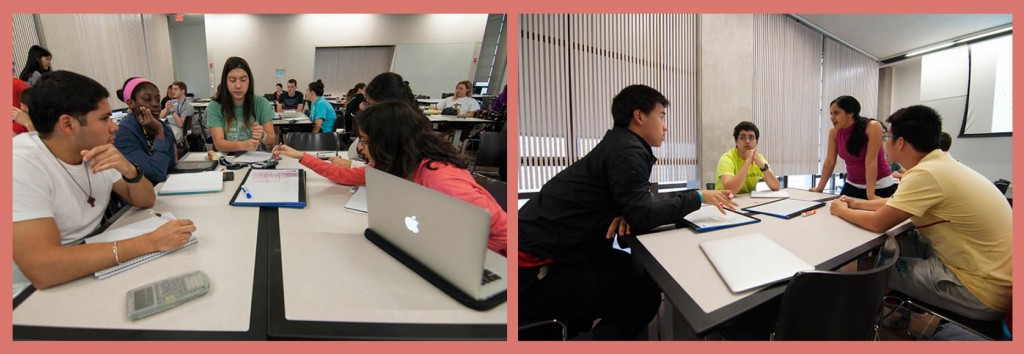
Brockman 101 is the SCAL@R classroom for GenChem designed as a large space to accommodate tables for small group discussions and problem solving. Tran and Hutchinson presented about SCAL@R at Rice’s Center for Teaching Excellence’s Teaching and Learning Symposium on January 15, 2015. Watch a recording of their teaching demonstration at http://cte.rice.edu/symposium.
Dr. Matthias Henze: A Holistic, Humanities-based Education
Tuesday, May 5th, 2015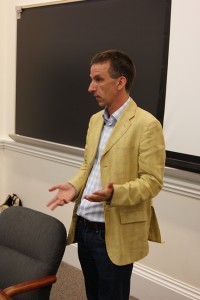
Dr. Henze, recently awarded the 2015 George R. Brown Award for Superior Teaching, lectures in Religion 392, Jerusalem: Holy City in Time and Imagination.
“Many of my students become better writers, and this is the greatest skill a student can have,” explains Dr. Matthias Henze, the Isla Carroll and Percy E. Turner Professor of Hebrew Bible and Early Judaism in Rice University’s Religion Department, who was recently recognized with the 2015 George R. Brown Award for Superior Teaching. Henze has written and edited nine books, has lectured internationally, has run at least one marathon on each of the seven continents, and has learned to communicate in many languages, both modern and ancient. This list of interests and skills is most impressive because Henze uses them as tools to create a stimulating classroom environment, to develop personalized courses for Rice students, and to constantly assess Rice University’s needs so that voids can be filled in Rice’s undergraduate education. Through his work as a Rice professor, Henze seeks to prepare students to positively impact the world through their careers and their lives.
When he arrived at Rice in 1997, Henze entertained a more traditional lecture style classroom, but he has exchanged that style of teaching for a more stimulating atmosphere with guided discussions. Engaging students in his language-based courses, his text-based courses, and his biblical book-based courses is not a challenge for Henze: “Students already have an interest in the material – reading the Bible offers a great teaching opportunity, because there is a lot at stake and students feel challenged.” Henze knows that each student has a unique motivation for enrolling in one of his 10-12 person seminars. Throughout the semester, Henze seeks to reach each of his students individually. He starts by learning their names, their reasons for selecting his course, and their background. Then, he utilizes assignments and class discussions to understand his students on a deeper level. For instance, in one of his courses, students journal through OWL-Space. Not only does Henze peruse these journal posts, he requires students to read and comment on each other’s reflections, too. “It’s helpful for students to process and document their own intellectual and emotional itineraries and to observe what others feel and have found and reflect on it,” Henze notes. While this activity benefits the students immensely, Henze connects with his students in and out of class by referencing ideas they have expressed in these journals, suggesting future reading for them based on their interests, and asking questions that help them to develop their thought processes.
According to Henze, the Humanities play a critical role in the education of undergraduate students regardless of major, year, or career goals. Henze believes that the Humanities help students in “becoming better writers and communicators and learning how to create, build, and defend an argument – skills really important in a constantly changing world that will help students adapt once they leave Rice for the career field.”
Henze has three specific goals that he uses to shape all of his courses. First of all, he wants his students to gain self-awareness of their identities, prejudices, and beliefs. Activities such as journaling accomplish this in an informal way, but Henze also prods this personal growth verbally by incorporating questions specifically geared towards his students to help them develop self-awareness.
Secondly, Henze wants to expose students to alternative viewpoints. “A college campus is a marketplace of ideas. It should be an environment where students are free to explore and express themselves without worrying about repercussions.” Participation is a critical aspect of Henze’s courses and does contribute to course grades. If a student is not interacting frequently, Henze takes time to identify why they might feel uncomfortable participating and encourages those students to participate to the best of their abilities.
Lastly, but most importantly, Henze believes that the ability to articulate and defend beliefs and arguments is invaluable. To develop this skill in his students, Henze’s courses include a rigorous formal writing component. For Henze, working one-on-one with students on their papers outside of class is one of the most rewarding parts of teaching. His students agree. In a course evaluation a few years ago, one student commented that while the content of Henze’s course might not be relevant for him in the future, Dr. Henze had made him a better writer. Henze notes, “While Biblical texts are my passion, I know that writing is what is most important for many of my students.” Additionally, students must make oral presentations, another integral component in defending one’s beliefs.
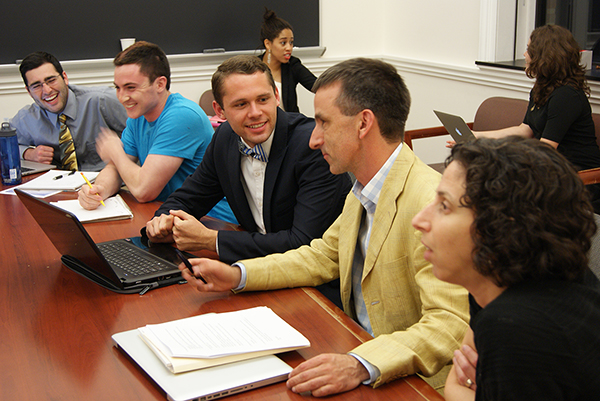
In his seminars, Dr. Henze and his students sit around a table to encourage participation and stimulate discussion amongst the entire group.
While Henze is clearly passionate about helping students in the classroom, he has also augmented the Rice community by establishing the Program for Jewish Studies (https://jewishstudies.rice.edu). While he himself is not Jewish, Henze realized that Rice has become a better place since it has begun to offer courses in Jewish studies because it has made Rice more “welcoming.” The majority of students in these courses are not Jewish but have an interest in Judaism. Many students are fascinated by issues such as identity, migration, and the treatment of minorities that the Jewish people have experienced throughout history. While there are several classes offered each semester (many of which are also cross-listed) in Jewish Studies, the Program for Jewish Studies has also created new opportunities for students such as stipends for studying abroad, language learning, social gatherings, and activities with Hillel.
In keeping with his philosophy of keeping students engaged, Henze has helped create a new course, “Jerusalem: Holy City in Time and Imagination.” This course is for any students who want to travel to Jerusalem during spring break, and the Program heavily subsidizes this trip, too. As he talked about this course, Henze paged through a travel guide that the students in this course had prepared for the trip. Each student was required to research and plan a visit to a site in Jerusalem. During the trip, the student had to present their site in Israel. Henze laughed as he remembered, “The tour guide for the trip was blown away!”
One of the best aspects of Rice University is that the professors seek to holistically educate students. Henze embodies this idea. Whether he is interacting with students one-on-one, in a small classroom, in a lecture, or through an opportunity in the Program for Jewish Studies that he developed to broaden and improve the undergraduate studies at Rice, Henze wants to help students learn to think, articulate, and defend themselves. He views a solid understanding of the Humanities as a launchpad for success in any career, and he genuinely desires to “foster intellectual independence” in each and every one of his students.
Anthony Bosman: Keeping It Real in Calculus Class
Wednesday, April 15th, 2015
“Intentional” is how Mathematics Instructor Anthony Bosman sums up his teaching style. Bosman, a graduate student in Mathematics, teaches Single Variable Calculus I and II (Math 101 and 102) and Multivariable Calculus (Math 212), by thoughtfully preparing materials that will connect the students to the subject matter and its applications in every day life. He realizes many of his students take the course only to complete a major requirement. So for some it is their last math class at Rice–even more motivation to make each lecture engaging and expose them to the practical uses of math.
As Bosman explains in his teaching blog, “Students become invested when they see how the material they’re studying will connect with the lived experiences of those in their immediate community. Real data examples help to make this connection. Even if not fully flushed out, they indicate that the things we’re learning have a purpose. They let students know that calculus can fight crime. It’s one thing to tell students that the gradient of a function lies perpendicular to its level sets. It’s quite another to show that a crime-fighting hero can calculate the gradient of a crime density function to find the hottest crime spots. That’s right, real heroes use vector calculus.”
Bosman aspires to reignite the sense of curiosity and wonder that abounds everywhere for young children but is often missing from classrooms labeled as formal places for learning. A slight change in topic can make a big difference in interest. In his Math101 class last summer, many of the students were athletes. In his lecture on why you might use the shell method for calculating the volume of an object rather than the disk method, Bosman selected a football as the object of study. Once the disk method proved inadequate to calculate the volume of the football, Bosman transitioned to the shell method and the class was able to verify the answer on the Internet.

Student engagement: holding a class outside on a perfect spring day, sample page of "notes with holes," and using everyday objects like soda cans as case studies.
To keep students actively engaged, Bosman literally gets them out of their seats. He conducts lectures outside on beautiful days or has team problem-solving competitions in the classroom with students working at the blackboards with their teammates behind them offering assistance. Bosman conducts his classes with a conversational tone so students feel like they are co-discovering new materials. All questions are celebrated by Bosman. “Instructors crave for students to ask questions–even the ‘bad’ ones–because they reveal what aspects of the lecture the students are understanding and what ideas haven’t been communicated effectively yet.” He hands out “notes with holes” at the start of each class that have some key topics listed with plenty of space for students to add their own notes. Often his assignments give students plenty of flexibility to find a subject they are interested it in so it overlaps with their life. One challenge was to graph something cool: responses included the Rice owl mascot and a student’s favorite football team’s logo.
Homework is not over once the student turns it in; it is returned so the student has the chance to make corrections and continue learning. After midterms, Bosman requires students to have a one-on-one meeting with him, which strategically increases their comfort level for future office visits. In these sessions, he encourages students to examine the areas of an exam that challenged them so they can focus on these areas for improvement. He discusses Stanford psychologist Carol Dweck’s theories on fixed and growth mind-sets to help them recognize that if they develop a growth mind-set they can develop their intelligence and learn from adversity. One of his students, who struggled early in the class, embraced this method and was one of the few with a perfect score on the final.
His students take the standard end-of-term questionnaire, but he explains, “by then, it’s too late to make changes.” So Bosman continually seeks feedback from his students in discussions, and brief surveys (some anonymous) throughout the semester, He prefers checking in on a regular basis to make sure he is in tune with this class. “If students were expected to understand everything the first time they saw it, we could simply record a lecture once and show it to all future generations of students. But this isn’t how learning works. Every classroom has a unique set of students that needs to have the content of a lecture uniquely tailored to them. It is the interplay of students asking questions and professors formulating responses that accomplishes this.”
Bosman credits Principles of Effective College Teaching as a valuable resource offered by Rice’s Center for Teaching Excellence. In addition to reviewing the literature on teaching and learning, the class challenged him to consider professors who modeled engaging teaching, such as Oliver Knill, his Harvard multivariable calculus summer course professor who started each one of his classes with a demonstration in order to form a connection between students and math.
For a class session on Halloween day, students determined the surface area of a pumpkin carved with the necessary formula. Bosman provided frosted doughnuts for calculating the surface area of the frosting–with the sweet treat as the reward for the correct answer. Bosman’s intention is to bring math alive by showing how it fits into daily life, “On the last day of class, I ask the students to reflect on what they would take with them from the course. One responded, ‘I’ll never eat a doughnut again without thinking of double integrals.’ Mission accomplished.”
Scott Rixner Revamps the Computer Science Classroom
Monday, February 23rd, 2015The technology world has changed drastically since 2000 when Dr. Scott Rixner arrived at Rice, but he has offered computer science students at Rice and around the world a unique learning experience by constantly adapting to this ever-changing field. While he has been a forerunner in the development of Massive Open Online Courses (MOOCs), a leader in the formation of flipped classrooms at Rice, as well as a successful computer science researcher, Rixner is most pleased with his creative teaching strategies because they allow him to interact with students more individually, “I feel that by spending more personal time with my students, teaching has been more rewarding.”
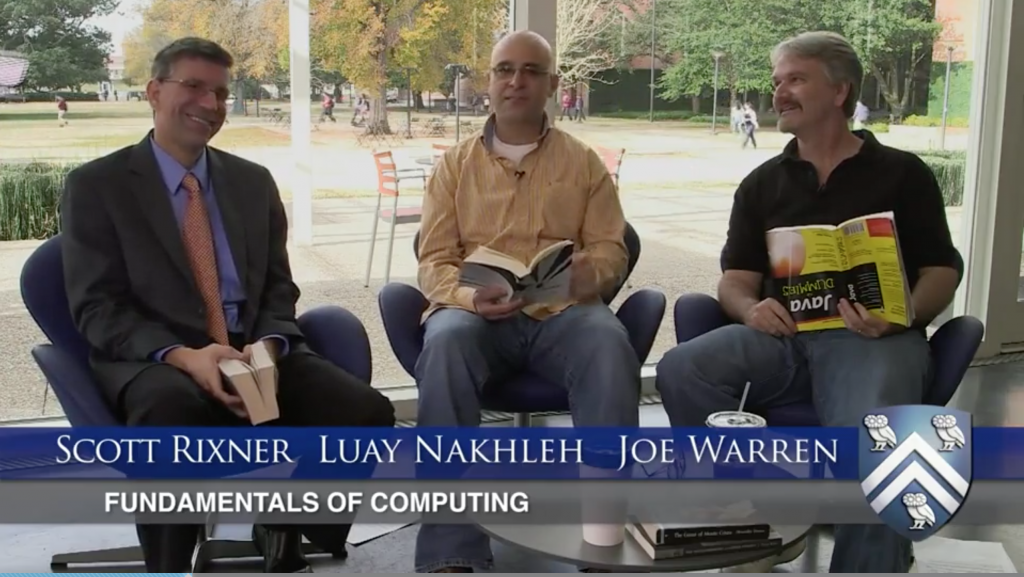
Dr. Scott Rixner along with Dr. Luay Nakhleh and Dr. Joe Warren in their introduction video to their current MOOC, Fundamentals of Computing. Click on the photo to check out this video and course!
Rixner teaches COMP 140, the introductory course for Computer Science majors. However, students in all majors and years of study want to take his course because it teaches a highly valued skill for all careers: a solid understanding of computer science. Demand for the course continues to thwart Rice’s reputation for small classes. In fact, COMP 140 increased from 140 students to 180 students in just two semesters. While the subject matter is enticing, students are also drawn to this course because of its innovative teaching methods.
In 2012, Rixner became involved with MOOCs. In six weeks, he developed CodeSkulptor (www.codeskulptor.org), an online interactive website that offers students exercises and instant feedback as they learn coding. After buying equipment, Rixner recorded and edited his video tutorials. During this process, he wanted his students to get to know him personally, so he decided to include a video of himself as he explains the concepts in the corner of his tutorials so that his virtual students would have a more personal and intimate classroom experience. His MOOC is offered on Coursera, and it has been met with an overwhelming response – 100,000 users started the course last time it was offered!
After a successful trial of his videos and CodeSkulptor with the MOOC, Rixner brought this incredible opportunity into his classroom at Rice. In 2013, Rixner realized that “the flipped classroom is an embodiment of the way technology has changed during my career. It is now much easier to deliver video and build web-based systems during and outside of class and has changed the way I teach. I augmented things by adding more technology in my classroom.” Rixner flipped his COMP 140 classroom by asking students to watch his videos and to take quizzes outside of class. When they arrive in class, they sit in three person groups and work together to do exercises on CodeSkulptor. Teaching Assistants and Rixner mingle and interact with students as they tackle the daily challenges.
Student feedback to this teaching style at Rice? Overwhelmingly positive – just like the feedback from Rixner’s MOOC. To keep students coming to class and supportive of their groups, Rixner makes class attendance part of their grade, and this group dynamic allows students to help each other learn and explore the material. This format has also given Rixner the chance to learn the names of every student in his class. Even when he taught 140 students, he knew every single student by name! And students know Rixner, too. Sometimes, freshmen walk into his class and say they took his MOOC before coming to Rice – further confirming that Rixner has positively impacted a broad audience both within and beyond the Rice hedges.
Outside of teaching, Rixner is currently pursuing two main research projects. One of his projects deals with building better software systems for small-embedded systems such as microcontrollers that are inside devices such as thermostats or watches. More recently, he began working on runtime issues in tablets and mobile devices.
Even though Rixner works with technology in his research and in his classroom, his favorite technology application is helping his students. He believes that technology is a vehicle for classroom enhancement and that the best aspect of using a flipped his classroom is that it “gives me many ways to spend more personal time with my students, and I think that is what makes technology in the classroom valuable.”
2014 Annual Report of the VPIT
Wednesday, December 24th, 2014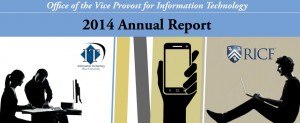 The juncture of a calendar year end with the midpoint of an academic year provides an ideal opportunity to review and preview IT projects developed at the request of our customers, or in collaboration with our colleagues. Originally written as a high-level IT overview for Rice’s executive leadership team, the Annual Report of the Vice Provost for Information Technology is now publicly available online. Some of the report highlights include:
The juncture of a calendar year end with the midpoint of an academic year provides an ideal opportunity to review and preview IT projects developed at the request of our customers, or in collaboration with our colleagues. Originally written as a high-level IT overview for Rice’s executive leadership team, the Annual Report of the Vice Provost for Information Technology is now publicly available online. Some of the report highlights include:
Multi-media, High & Low Tech Tools for Teaching and Learning
From media assets like digital film clips and audio files to class participation from a mobile device to storytelling as a course project, Rice faculty and students continue using both high and low technologies in active learning environments. However, Rice instructors also engage their students in active learning with little or no technology. The teaching and learning stories in this report illustrate how IT’s Academic Technology Services staff members help Rice instructors find solutions for learning activities that have become time-consuming and detract from the actual learning goals of the course. Read more on pages 4-5.
BlueGene P & Q, Power8, and BiRD Cloud Support for Researchers
IT supports research computing clusters like the BlueGene P & Q clusters, the IBM Power8, and BiRD Cloud, where Rice researchers and their external colleagues are working on a variety of problems related to energy, geophysics, life sciences, and cancer research, how to extrapolate solutions for medical research and clinical practices from big data and analytics technologies, as well as how to best use hybrid cloud environments to enhance code development and interactive data analysis with tools like Matlab, R, and Hadoop. Read more on pages 6-7.
Training Opportunities for Instructors and Researchers
From helping postdocs with their high performance computing (HPC) code to introducing new instructors to the tools on their classroom podium computers and the many features of OWL-Space, IT staff members provide multiple workshops for Rice community members. Read more on pages 8-9.
Campus-wide Initiatives Improve Network, Systems, and Security
How Rice faculty, staff and students access the university’s vast array of digital resources depends on a highly available and efficient infrastructure composed of a quick network with a hearty bandwidth and robust systems that can manage torrential surges of traffic and data on an hourly basis. This infrastructure must also be able to identify, withstand, and rebuff cyber attacks designed to usurp university resources and data and slow down competitive research. The 2014 report does an especially good job of explaining the infrastructure and security improvements currently underway across the campus. Read more on pages 10-12.
Collaboration Results that Solve Administrative Process Challenges
From improvements to blogging tools used by faculty, staff and students to radios used by RUPD, IT has continues to partner with colleagues across the university to help solve administrative process or equipment challenges that prevent Rice community members from achieving their daily tasks in an effective way. Several of these interdepartmental collaborations are featured in this report, including an interim solution for the faculty hiring process and a system that helped a committee use big data analytics in a presentation on corporate partnership trends for the Board of Trustees. Read more on pages 13-15.
Kamran Khan
Vice Provost for Information Technology,
Rice University
Ensemble: Beyond the Playlist
Tuesday, December 16th, 2014In summer 2014, Ensemble was introduced as Rice’s new resource management system. Ensemble replaces a collection of tools that had grown unwieldy. Two distinct audiences need to access digital film clips at Rice: (1) faculty and students use digital media clips in their courses and (2) the general public is interested in videos of special events, from guest speakers to graduation ceremonies. An excellent way to explore a Rice web page that currently uses Ensemble to group and display media assets is http://mediahub.rice.edu, the portal for university events recorded by the Educational Productions team.
Why Use Movie or Audio Clips?
Rice professors often use a supplemental reading list as a class resource and they reference excerpts from the texts in lectures, class discussions or homework assignments. An increasing amount of multi-media resources have been drawn into Rice classes and media playlists may supplement or replace traditional reading lists. Audio and video lists, also known as playlists, are easily included in Rice course sites in OWL-Space. In a previous IT News article, Dr. Peter Lowen described loading audio files for students to listen to while reading they read the composer’s score.
In addition to digital clips from externally produced films, some Rice instructors include video capture recordings of their classroom presentations; other faculty create self-recorded videos of their lectures, lab techniques, and other demonstrations. Rice students can also be asked to create videos as assignments. For example, students in one course were required to show their understanding of a topic by recording a video of their explanation. The videos were submitted only to the instructor and the instructor graded videos rather than papers. In the HUMA 300 course –part of the Poverty, Justice and Human Capabilities minor– instructor Anne Dayton used peer reviews of student-created videos and images. The videos and images were uploaded to a private blog for review by other students in the class, instead of being submitted only to the instructor.
Organizing Media Assets
Obviously, instructors using a lot of videos also need a tool that allows them to organize the many digital media assets they are accumulating. The organizational tool must work well with OWL-Space, the university’s learning management system. As early as 2011, IT’s Academic Technology Services (ATS) team began searching for a solution that could group digital media assets by common themes, display images or readings associated with a particular film, and provide an area beside the clip for comments. The solution needs a student submission process, one that can be customized to meet the instructor’s plans for the student videos. For example, an instructor using student videos for peer review discussions requires an automated and immediate publishing process so the rest of the class can quickly watch and comment on the new clips. However, the faculty member who is requiring video submissions for a grade might prefer a moderated process, which allows the instructor to select which videos to share with the rest of the class.
Ensemble works well with OWL-Space, but it also easily supports media assets that are frequently viewed by the public. For information on using Ensemble in a Rice course or in conjunction with departmental web sites, contact the ATS team at academictech@rice.edu.



